Commercial implementation of biofloc and RAS production systems help control shrimp farming diseases
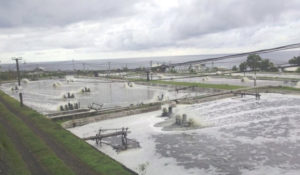
Before the mid-1990s, the major diseases affecting the farmed shrimp industry were of bacterial origin. But in Asia and from late 1994, the appearance of various, major viral diseases – like White Spot Syndrome Virus (WSSV), Yellow Head Virus (YHV), Infectious Myonecrosis Virus (IMNV) and others – led to changes in the design and operation of some shrimp farms to help prevent outbreaks and dissemination of viral diseases.
More recently, WSSV outbreaks in Saudi Arabia in farming operations for Indian white shrimp (Penaeus indicus) provided more evidence that additional biosecurity was needed. And since 2009, outbreaks of a new bacterial disease, Acute Hepatopancreatic Necrosis Syndrome (AHPNS) – which started in China and spread to Vietnam, Malaysia and Thailand, and later to Mexico in 2013 and Central America in 2015 – has caused losses of billions of dollars. Other disease outbreaks in Brazil in 2016 and WSSV in early 2017 in Australia at black tiger shrimp (Penaeus monodon) farms provide additional evidence for the need to change shrimp production systems.
Because of old and newly emerging viral and bacterial diseases affecting their farmed shrimp industry, some years ago various Asian countries started developing and using biofloc and recirculation aquaculture system (RAS) production technologies and/or treating incoming water for culture operations and wastewater treatment as biosecurity measures for disease prevention and control.
Here I discuss examples of different biofloc and recirculation aquaculture (RAS) shrimp farming systems used in Asia in the last two decades, including some of the projects I have personally been involved with and provided technical expertise, as well as some perspectives on these technologies.
Single pond with common canal management (Indonesia)
The company PT Dipasena Citra Darmaja (DCD) was established in 1987 and developed a 16,250-hectare uninhabited swampland concession on the northeast coast of Lampung Province, South Sumatra, into an integrated shrimp farm with more than 18,000, 0.20-hectare ponds.
The farm operated under what is commonly known as the “plasma” profit-sharing system, where each qualified family runs two 0.20-hectare ponds with management assistance from DCD. In 1995, the company expanded and developed an adjacent concession of about 124,000 hectares. More than 7,700 ponds of 0.25 to 1.80 hectares were built for a total area of nearly 3,800 hectares. A subsidiary company, P.T. Wachyuni Mandira, was allotted one-third of this area for operation in the same “plasma” system, and the remaining ponds were company assets.
The farm was originally designed and constructed based on single pond operators and a common canal management system. Ponds were arranged in rows with supply and discharge canals on opposite sides. The main effluent canals were built not only to discharge drainage waters from culture ponds, but also to be utilized as waterways for logistical management purposes by speed boats and barges. The water source was directly from the coast area, whereas the wastewater was discharged into large upstream rivers adjacent to the farms. Production operations using canals and a single pond system for the production of black tiger shrimp, Penaeus monodon, were successful until the emergence of viral pathogens, especially WSSV in the mid-1990s.
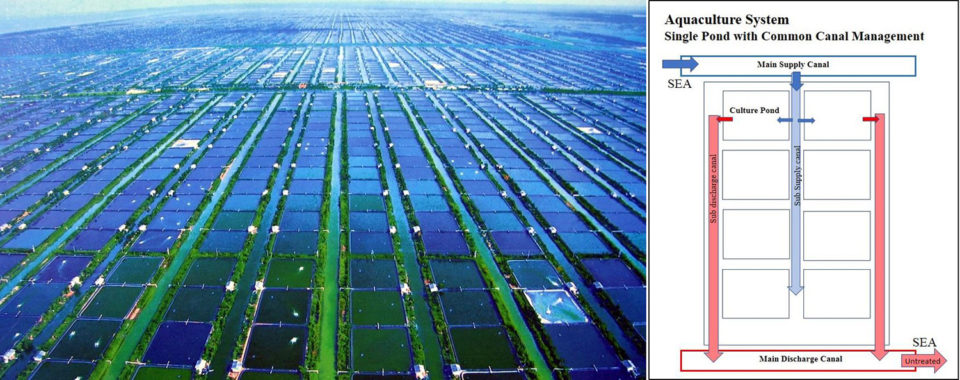
Most farms in shrimp-farming countries, including Indonesia, began to modify their operations to include reservoirs to treat culture water before use. However, the Dipasena operation continued using the single-pond culture system, which led to low and unsustainable production levels.
When new management took over in 2006, the single-pond system was re-engineered into modules with 20 percent reservoirs at the main supply canal side. Implementation of this modular system revitalized the operation and led to stable production, applying a minimum water exchange and using only treated water in culture production ponds. However, the system had no wastewater treatment system for effluents discharged from the culture ponds during operation and harvest. At the time, the facility was also transitioned to a new species, the Pacific white shrimp, Litopenaeus vannamei.
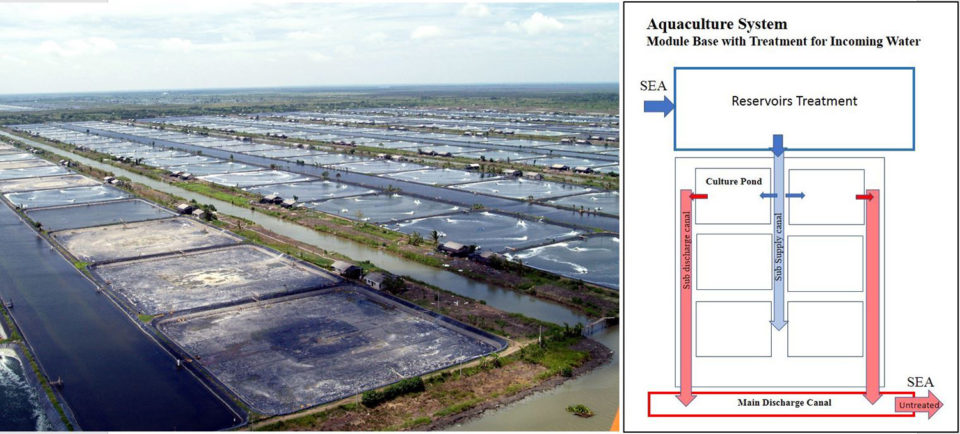
Single pond base with wastewater treatment system (Indonesia)
The PT Sekar Abadi Jaya (SAJ) shrimp farm in West Sumbawa, Indonesia, used sea water directly for its production ponds. The farm had an efficient effluent treatment system starting with a settling basin and raceway canals, two stages where effluents (tested and approved by the Indonesian Department of Environment) were treated before being discharged back to the ocean.
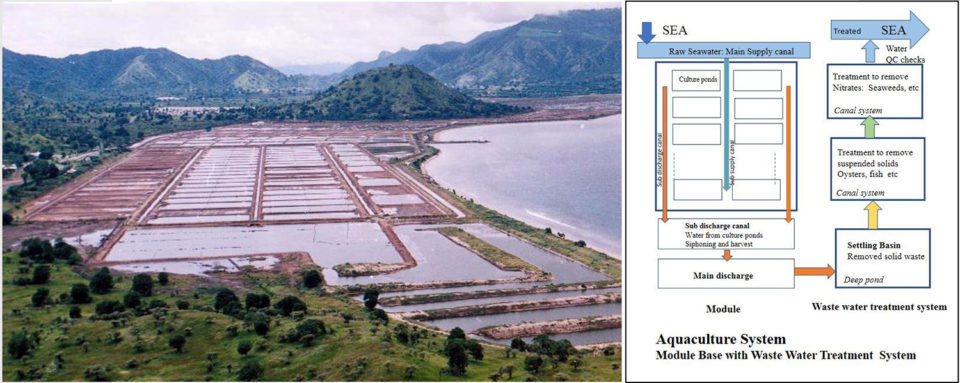
Recirculation aquaculture system within modules (Indonesia)
In Indonesia, the Charoen Pokphand group at the P.T. Central Pertiwi Bahari (CPB) shrimp farm in Lampung, South Sumatra, operates on a modular basis, where each module consists of 40 to 60 square, half-hectare ponds with its own reservoirs and effluent treatment ponds, including a recirculating canal from the production ponds that flows to the sedimentation ponds. The water surface area of the reservoirs/sedimentation ponds is 20-25 percent that of the production ponds. This arrangement was a possible factor during disease outbreaks after facility start-up. The farm systems were redesigned with minimum or zero water exchange at certain periods of the culture cycle.
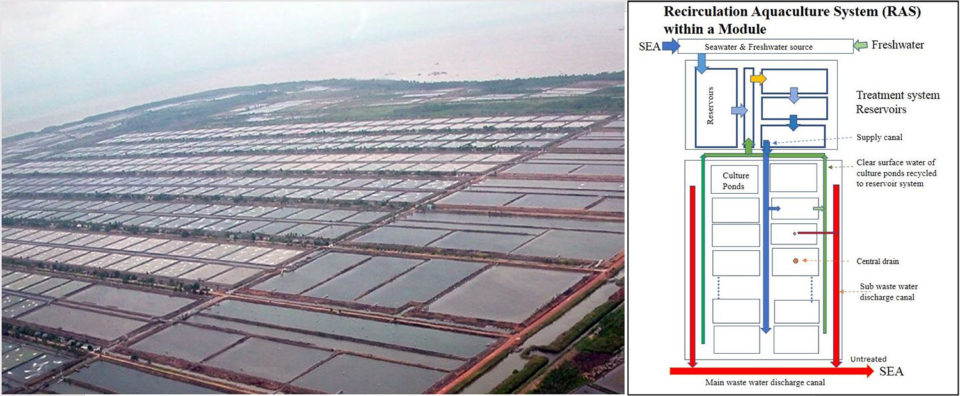
Single pond base with reservoirs and wastewater treatment system (Malaysia)
Blue Archipelago’s Arca Biru Sdn. Bhd. shrimp farm is in Kedah, northwest of Kuala Lumpur. Initially known as Samak Aquaculture, the farm was established in the early 1990s for the culture of black tiger shrimp. The original farm layout was a pond culture system with an excellent seawater intake from an extended, 2.4-kilometer canal.
The farm had 226 earthen ponds, most of which were 0.8 hectares in size, arranged in rows with supply and discharge drainage canals on opposite sides. Two large reservoirs supplied treated seawater, while sedimentation ponds treated wastewater before discharging back to the sea. The main supply gates were based on irrigation canal gates with wooden planks to let water into secondary supply canals. The outlet or harvest gates of culture ponds used conventional wooden sluice planks for flow-through pond operation. There was no central drain or harvest pit in the system.
In early 2010, the farm was redesigned to a biosecure modular system from rows of single ponds to a biosecure modular system lined with high-density polyethylene (HDPE) and with reservoirs for water treatment. Two modules were fully lined with HDPE, and the remaining modules were lined only on their internal pond dikes. The farm still has 226 ponds, but each new module consists of 20 0.8-hectare ponds and two culture ponds of 0.4 to 0.6 hectares each. Four 0.8-hectare ponds beside the main supply canals were modified into reservoirs for each module.
All inlet supply and discharge gates were rebuilt to a more biosecure design to make sure there are no leakages. A central drain system was installed to get rid of sludge during culture operations and to increase the carrying capacity of the ponds. The revamped seawater supply system moves the water through the four treatment ponds before it reaches the culture ponds – this ensures that only treated water enters the culture ponds within a module.
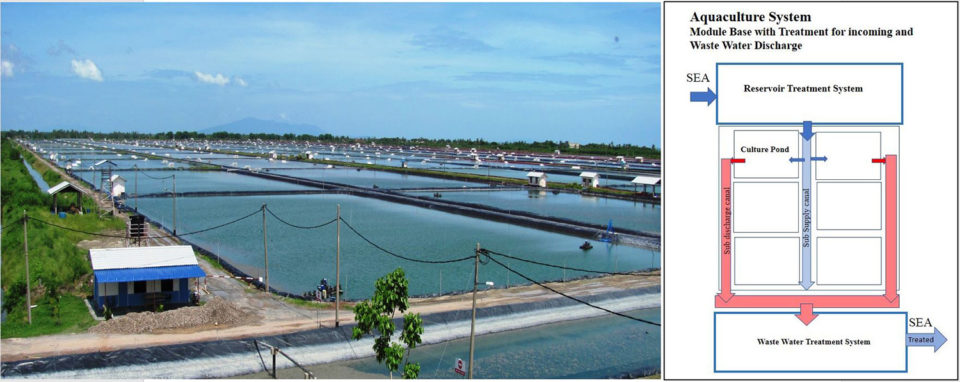
Recirculating aquaculture system (Malaysia)
The iSHARP project in Malaysia was designed as a recirculating aquaculture system (RAS). All discharge waters are directed to a main settling basin to be treated for reuse or discharge back to the environment. The treatment system involves four phases: beyond the settling basin, large first and second treatment canals contain fish, mussels, oysters and seaweeds for biofiltration of suspended particles and nitrification of dissolved effluence, while the fourth and final ponds provide aeration and chemical treatment with chlorine or liming before the water is returned to the main supply canal or discharged. Water quality parameters such as chemical and biochemical oxygen demand, total ammonia nitrogen and phosphate levels are routinely checked against local government requirements.
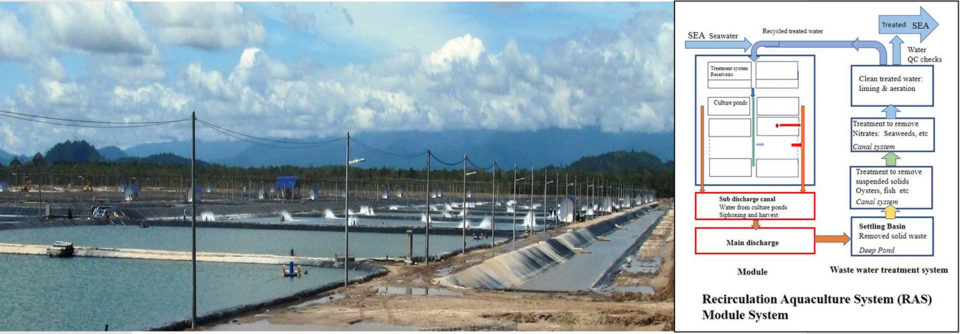
The quality of the final discharge water from the wastewater treatment system is as good as the seawater source, and for culture operation it is treated again just like incoming seawater. The water is then pumped into the main supply canal and from there pumped again into the reservoirs within modules. The water is treated again for specific pathogens, as required, in the reservoirs before being pumped into the culture ponds. There are four reservoirs in one module, with two rows consisting of 24 culture ponds.
The recirculation aquaculture system practices in this project in Malaysia were described by the author in 2013, and biofloc technology – the self-nitrification process within culture ponds – is also well known. A recirculation aquaculture system does not mean that the water lost due to siphoning of sludge, evaporation and seepage is not replenished, as the water required during operations must be replaced as required with new treated water.
The project is very fortunate to have the two systems (double RAS) combined to make the farm a more biosecure and sustainable shrimp facility than many other typical farms. The project started its first stocking in two modules in October 2011, and, since then, the farm has been operating without any reported incidents of shrimp diseases.
Perspectives
Many production systems are used by Asian shrimp growers – from single-pond base management to larger RAS systems – but many have yet to reduce their environmental impact due to their wastewater discharges. Investors and small-scale shrimp farmers need to be made aware of other available production systems so they can make a choice, and the shrimp farming industry needs to find a way to better prevent these impacts, including more implementation of certification schemes like the Global Aquaculture Alliance’s Best Aquaculture Practices.
A similar situation exits in shrimp broodstock, hatcheries, nurseries and also in raceway production facilities, without proper treatment of wastewater produced during their operations. The environmental impact of wastewater discharged from these facilities were also a major issue in disease outbreaks and dissemination to other facilities. However, in these facilities, RAS technology has been applied successfully.
Biofloc systems offer stable and sustainable production because they support self-nitrification within fish or shrimp culture ponds with zero water exchange. Biofloc systems reduce the risk of shrimp disease because the low rates of water exchange support pathogen exclusion and biosecurity, the continuous aeration provides stable water quality (DO and pH), a diverse and stable microbial community stimulates the non-specific immune system of cultured animals and limits development of opportunistic species like Vibrios, and the regular removal of accumulated sludge controls biofloc concentration to moderate levels.

Recirculation aquaculture systems re-utilize the water and use mechanical and biological filters, and the limited amount of water used is beneficial because water is a limited resource in many regions. The term “zero-discharge” is sometimes used in connection to aquaculture, and although all water and sludge discharges from farms can be contained, the wastewater treatment is often costly. Also, the limited use of water makes it much easier and cheaper to remove the nutrients excreted by the cultured animals, as the volume of discharged water is much lower than that discharged from a traditional shrimp/fish farm. Recirculation aquaculture can be considered a most environmentally friendly way of producing shrimp/fish at a commercially viable level. And the nutrients from the farmed shrimp/fish can be used as fertilizer on agricultural farming land or as a basis for biogas production.
Taw, Table 1
| Production system | Flow-through | RAS low level | RAS intensive | RAS super intensive |
|---|---|---|---|---|
| Fish: new water volume %/day (Bregnballe 2015) | 1,028% | 103% | 34% | 6% |
| Shrimp: new water volume %/100-day cycle | 1,000% | 20% (semi-biofloc) | 10% (biofloc) | 1% (raceways, zero water exchange) |
In any aquaculture business, sustainability of a system can improve profits. With emerging disease problems, treating wastewater discharged from farming facility or RAS is of utmost important. What investors, shrimp farmers and technicians need to be aware of is that, whatever waste is discharged into the environment, it will likely come back to you in the form of disease sooner or later.
References available from author.
Author
-
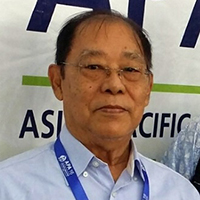
Nyan Taw, Ph.D.
Shrimp Aquaculture Consultant
Former Sr. Technical Adviser/GM Blue Archipelago BHD, Malaysia, CTA of FAO Projects of the UN, and SVP/ VP of integrated shrimp farming companies (Dipasena and CPB) in Indonesia
Kuala Lumpur, Malaysia
[109,111,99,46,108,105,97,109,103,64,49,119,97,116,46,110,97,121,110]
Tagged With
Related Posts
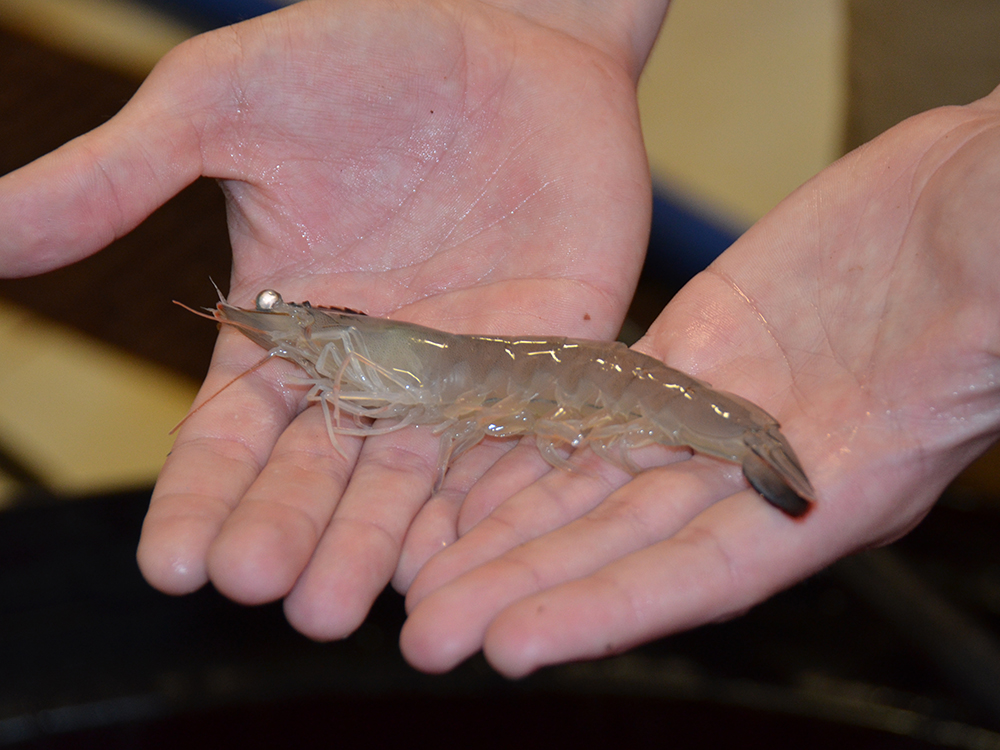
Aquafeeds
Biofloc and clear-water RAS systems: a comparison
This study compared two types of indoor, shrimp culture systems: clear-water RAS and biofloc systems. Clearwater RAS had the edge in water quality, but shrimp in the biofloc treatment had a higher feed conversion ratio.
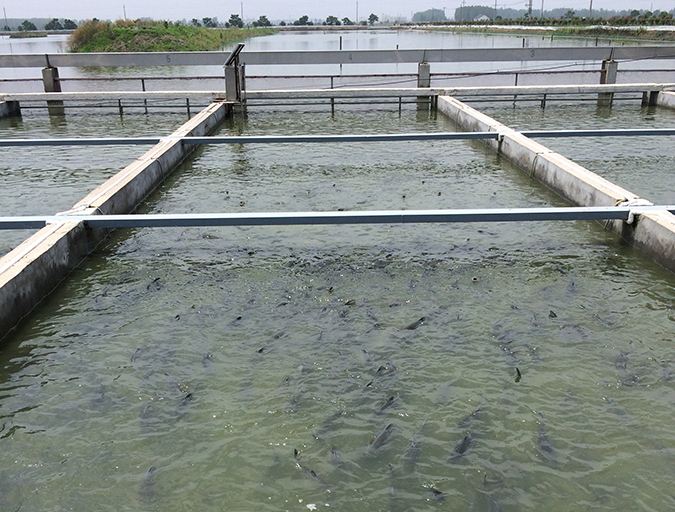
Innovation & Investment
GOAL 2016 preview: IPA technology catching on in China
Intensive pond aquaculture (IPA) technology, a floating, in-pond raceway system developed in the United States, is being adopted fast in China, just three years after its introduction, says Jim Zhang, aquaculture program manager for USSEC-China.
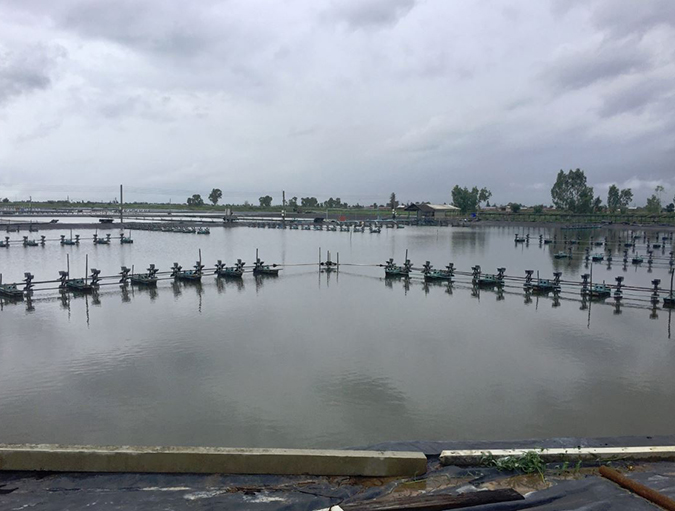
Health & Welfare
Aquamimicry: A revolutionary concept for shrimp farming
Aquamimicry simulates natural, estuarine production conditions by creating zooplankton blooms as supplemental nutrition to the cultured shrimp, and beneficial bacteria to maintain water quality. Better-quality shrimp can be produced at lower cost and in a more sustainable manner.
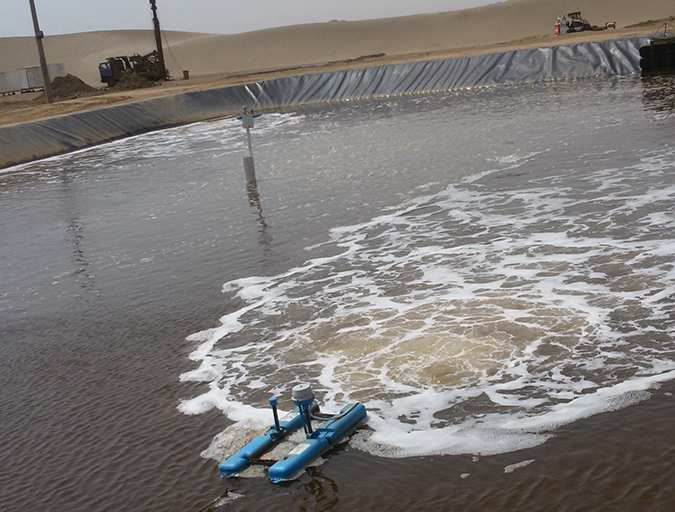
Health & Welfare
Shrimp biofloc production trials in Saudi Arabia
An R&D trial was conducted with shrimp biofloc technology at a commercial facility in Saudi Arabia. Results indicated that biofloc technology can be effectively applied, with some protocol adjustments, in the KSA’s extreme desert environmental conditions.

